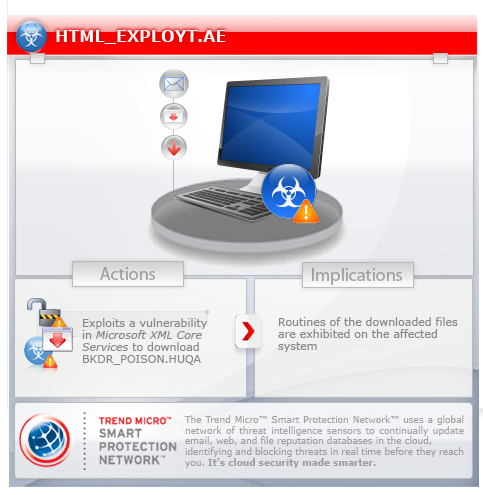HTML_EXPLOYT.AE
Exploit:JS/ShellCode.AT (Microsoft), Hacktool.IE.Exploit (Symantec), Exp/20121889-A (Sophos), Exploit.HTML.CVE-2012-1889 (v) (Sunbelt), JS/ShellCode.BAAC!exploit (Fortinet)
Windows 2000, Windows XP, Windows Server 2003


Threat Type: Trojan
Destructiveness: No
Encrypted:
In the wild: Yes
OVERVIEW
Spammed via email, Dropped by other malware, Downloaded from the Internet
This malware exploits the vulnerability in Microsoft XML Core Services, which prompted Microsoft to release a fix tool.
To get a one-glance comprehensive view of the behavior of this Trojan, refer to the Threat Diagram shown below.

This Trojan arrives as an attachment to email messages spammed by other malware/grayware or malicious users. It arrives on a system as a file dropped by other malware or as a file downloaded unknowingly by users when visiting malicious sites. It executes when a user accesses certain websites where it is hosted.
It takes advantage of software vulnerabilities to allow a remote user or malware/grayware to download files. It executes the downloaded files. As a result, malicious routines of the downloaded files are exhibited on the affected system.
Once a user visits an affected Web page, this HTML script launches a hidden IFRAME that connects to a malicious URL. This is the Trend Micro detection for Web pages that were compromised through the insertion of a certain IFRAME tag.
TECHNICAL DETAILS
12,063 bytes
HTML, HTM
26 Jun 2012
Downloads files
Arrival Details
This Trojan arrives as an attachment to email messages spammed by other malware/grayware or malicious users.
It arrives on a system as a file dropped by other malware or as a file downloaded unknowingly by users when visiting malicious sites.
It executes when a user accesses certain websites where it is hosted.
Download Routine
This Trojan connects to the following website(s) to download and execute a malicious file:
- http://{BLOCKED}ia.co.in/css/css.exe - detected as BKDR_POISON.HUQA
It takes advantage of the following software vulnerabilities to allow a remote user or malware/grayware to download files:
It then executes the downloaded files. As a result, malicious routines of the downloaded files are exhibited on the affected system.
Other Details
Once a user visits an affected Web page, this HTML script launches a hidden IFRAME that connects to a malicious URL.
It inserts the following code:
- http://www.{BLOCKED}9.com.hk
SOLUTION
9.200
9.218.02
26 Jun 2012
9.219.00
27 Jun 2012
Step 1
For Windows XP and Windows Server 2003 users, before doing any scans, please make sure you disable System Restore to allow full scanning of your computer.
Step 2
Remove malware files dropped/downloaded by HTML_EXPLOYT.AE
- BKDR_POISON.HUQA
Step 3
Scan your computer with your Trend Micro product to delete files detected as HTML_EXPLOYT.AE. If the detected files have already been cleaned, deleted, or quarantined by your Trend Micro product, no further step is required. You may opt to simply delete the quarantined files. Please check this Knowledge Base page for more information.
Step 4
Download and apply this security patch Refrain from using these products until the appropriate patches have been installed. Trend Micro advises users to download critical patches upon release by vendors.
Did this description help? Tell us how we did.

